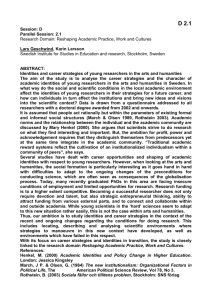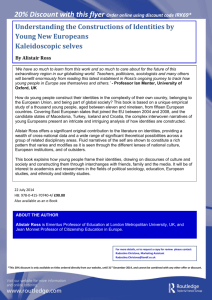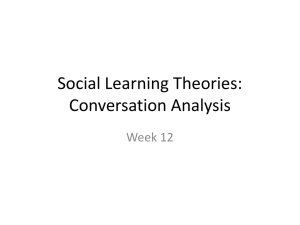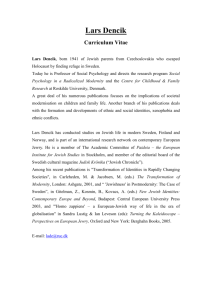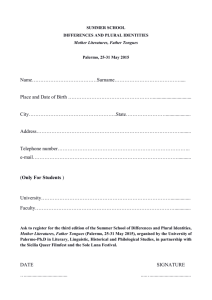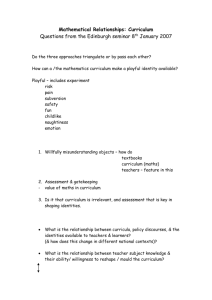Occupation and Identity Construction
advertisement
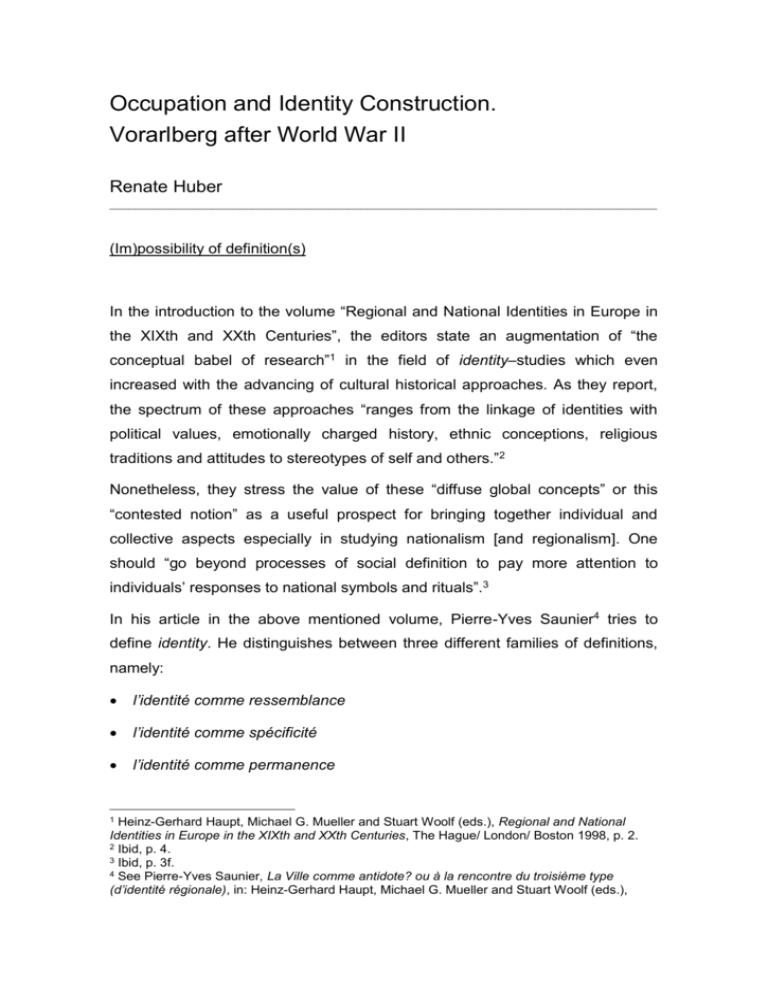
Occupation and Identity Construction. Vorarlberg after World War II Renate Huber _____________________________________________________________________________________ (Im)possibility of definition(s) In the introduction to the volume “Regional and National Identities in Europe in the XIXth and XXth Centuries”, the editors state an augmentation of “the conceptual babel of research”1 in the field of identity–studies which even increased with the advancing of cultural historical approaches. As they report, the spectrum of these approaches “ranges from the linkage of identities with political values, emotionally charged history, ethnic conceptions, religious traditions and attitudes to stereotypes of self and others.”2 Nonetheless, they stress the value of these “diffuse global concepts” or this “contested notion” as a useful prospect for bringing together individual and collective aspects especially in studying nationalism [and regionalism]. One should “go beyond processes of social definition to pay more attention to individuals’ responses to national symbols and rituals”.3 In his article in the above mentioned volume, Pierre-Yves Saunier4 tries to define identity. He distinguishes between three different families of definitions, namely: l’identité comme ressemblance l’identité comme spécificité l’identité comme permanence 1 Heinz-Gerhard Haupt, Michael G. Mueller and Stuart Woolf (eds.), Regional and National Identities in Europe in the XIXth and XXth Centuries, The Hague/ London/ Boston 1998, p. 2. 2 Ibid, p. 4. 3 Ibid, p. 3f. 4 See Pierre-Yves Saunier, La Ville comme antidote? ou à la rencontre du troisième type (d’identité régionale), in: Heinz-Gerhard Haupt, Michael G. Mueller and Stuart Woolf (eds.), 2 According to him, identity is first of all ambiguity; ambiguity between the collective and the individual, between instantaneity and durée, between difference and similarity. Furthermore, he suggests to look at identity not as the reason for the relationship between different groups, but as the relationship itself. Trying to find my own definition of what I assume under identity, I stumbled in the dictionary on the term Identikit, a composition of the words identity and kit, which is defined as “a reconstructed picture of a person (esp. one sought by the police) assembled from transparent strips showing typical facial features according to witnesses’ descriptions”5. The more I examined this explication, the more I found the metaphor behind it very useful for explaining research in the field of identities. If one takes this text word by word, one can find more or less the whole spectrum of what seems to be important in the research of identities. The reconstructed picture for instance implies a re-construction of the construction of an image, which includes as well the possibility of deconstruction. If one takes some of these transparent strips away (and possibly puts in some others), the image of the person will surely be different. By replacing person with individual on the one hand and typical features with collective characteristics shared by a number of people on the other, the field of tension between the groups and its single member becomes more visible. So, is the witness able to find exactly the right individual feature in the huge number of different possibilities? The different transparent strips - each one for itself - seem to be neutral, even without any evidence for the whole. Only by putting these quasi-transparent fragments together, a certain image is emerging. But is this image subsequently more or less transparent, more or less evident? As the focus for this construction of images lies on facial features, it is clear that only one - although important – part of the body seems to be worth examining. Regional and National Identities in Europe in the XIXth and XXth Centuries, The Hague/ London/ Boston 1998, p. 130 and 134. 5 The Concise Oxford Dictionary of Current English, 9th ed., Oxford 1995. 3 (Here the question comes in if one knows much more about a person by knowing how its feet or legs look like.) Then, two other important aspects have to be emphasized: according to witnesses’ descriptions means that this person has been present at some event and able to give information about it as well as the way a person gives these representations are of crucial interest. It was not only this explication of identikit which attired my attention on this metaphor, but also something else: as a German speaking person, I immediately linked the English term kit6 with German Kitt which signifies some sort of (sealing) cement or filling compound. So to say or so to ask, what is the Kitt of identikit, or, to come back to German, of the Phantombild? What is the cement which helds together all these fragmentary puzzles of identity construction? What’s about concrete interests, about myths and ideology, memory and consciousness? Or, what’s about “the ghosts of the past”, as Luisa Passerini asked in her seminar7 entitled “’Ghost Dog’: The Double Relationship Between Historical Epochs” last Thursday. I do not feel able to give any further definition of identity. To my mind, it’s even impossible to give a universally valid definition of this notion. What seems to be really important is to be aware of and reflect the own position during the whole process of re- and de-constructing all these different “foils of identity”. Identity Construction, Perception and Consciousness Collective identities are, as Shmuel N. Eisenstadt and Bernhard Giesen state, “not naturally generated but socially constructed”8. In the very most cases, 6 = a set of all the parts needed to assemble an item, e.g. piece of furniture, a model, etc. See The Concise Oxford Dictionary. 7 Seminar Spring term 2000 “Who is Afraid of Cultural Studies” 8 Shmuel N. Eisenstadt and Bernhard Giesen, The construction of collective identity, in: Archives Européennes de Sociologie, no. 1, 1995, p. 74. 4 these identity construction processes are initiated and reinforced by elites.9 Therefore, studying these construction processes means mostly to deal with classic top down models, namely, to examine the role of the elite(s), their efforts, intentions and interests for producing feelings of cohesion between people. Nevertheless, it goes without saying that this process cannot be explained only in a one way perspective. It should be rather interpreted as the result of an interaction process between the realisation of this identity construction process and one’s individual or group perception and interpretation of it,10 that is to say as the constantly redefined relationship between different actors in “imagined communities”11 in space and time. Furthermore, according to the “stress theory”12, certain circumstances (e.g. situational pressure and feelings of insecurity) are likely to raise the need to invoke community and cohesion. The constellation of a “society in crisis” leads, as Ingrid Bauer13 underlines it for the post-war-period in Austria, to specific stabilization mechanisms. Or, to speak with Stefano Bartolini, Thomas Risse and Bo Stråth, “identity becomes a problem when there is no identity, particularly in situations of crisis and turbulence, when established ties of social cohesion are eroding or breaking down.”14 See e.g. the ongoing discussion in the seminar “Between Europe and the Nation State: The Reshaping of Interests, Identities and Political Representation” at the European Forum/ Robert Schuman Centre for Advanced Studies. See as well Markus Barnay, Die Erfindung des Vorarlbergers. Ethnizitätsbildung und Landesbewußtsein im 19. und 20. Jahrhundert, Bregenz 1988. 10 See Willem Frijhoff, La ville: lieu de mémoire de l’Europe moderne?, in: Pim den Boer and Willem Frijhoff (eds.), Lieux de mémoire et identités nationales. La France et les Pays-Bas, Amsterdam 1993, p. 61. 11 See Benedict Anderson, Imagined Communities. Reflections on the Origin and Spread of Nationalism, London 1983. 12 See Klaus Peter Fritzsche, Stressgesellschaften und Xenophobie, in: Yves Bizeul et al. (eds.), Vom Umgang mit dem Fremden. Hintergrund – Definitionen – Vorschläge, Weinheim/ Basel 1997, p. 68. 13 See Ingrid Bauer, “Die Amis, die Ausländer und wir”. Konstrukte und Erfahrungslagen von “selbst” und “fremd” im Jahrzehnt nach dem Zweiten Weltkrieg: Das Fallbeispiel Salzburg, in: Vielfältige und schwierige Fremdheit: Historische Erklärungsszenarien. Projektbericht im Rahmen des Forschungsschwerpunktes „Fremdenfeindlichkeit“, erstellt im Auftrag des Bundesministeriums für Wissenschaft und Verkehr, Salzburg 1998, p. 210f. 14 Seminar Paper EUR/1 of Stefano Bartolini, Thomas Risse and Bo Stråth, Between Europe and the Nation State: Introduction into the Forum Themes, 7 October 1999, European Forum, p. 14f. 9 5 In my view, experiences of the self and the other15 are additional crucial variables in this context of identity construction, perception and consciousness. Without knowing what is the other or what is perceived as the other, one can hardly define the self. Therefore, questions of in- and exclusion, of belonging and not-belonging, of in- and out-groups are of high interest. In the context of occupation, it seems to be even more important to focus on relationships between these different groups from the in- and the outside of such ‘imagined communities’ because force and power are not factors equivalently splitted up between them.16 To speak with Anna Triandafyllidou17, the role of the “significant other” has to be examined, and not only the “internals” as the occupation force(s), but also the “externals”, for instance neighbour-states or former occupation force(s). These “significant others” can be seen as sort of mirror to reflect images of the self as well as of the other.18 Regional and National Identities After this rather theoretical introduction, I would like to tell you now about a few aspects of my own research project. I have chosen for my microhistorical approach the most western province of Austria, at the Swiss and German border, called Vorarlberg. There, I will focus on the principles and mechanisms of constructing and constituting regional and national identities and the relationship of one on to the other. Both categories are territorially based and abstract, even if the degree of abstraction varies: regions are more easily erfahr-bar19 than nations resp. nation-states. In contrast to local as a further See e.g. our project report entitled “Multifaceted and Complex Strangeness: Historical Interpretive Scenarios” (orig.: s. footnote no. 12). 16 See Ingrid Bauer, Welcome Ami go home. Die amerikanische Besatzung in Salzburg 1945 1955. Erinnerungslandschaften aus einem Oral-History-Projekt, Salzburg/ München 1998. 17 See the Seminar Paper EUR/24 of Anna Triandafyllidou, Images of the Other and the Reshaping of Collective Identities in a ‘United’ Europe. A theoretical introduction, 2 March 2000, European Forum, p. 10ff. 18 See e.g. the Seminar Paper EUR/1 of Stefano Bartolini, Thomas Risse and Bo Stråth, Between Europe and the Nation State: Introduction into the Forum Themes, 7 October 1999, European Forum, p. 14f. 19 In the double sense of the German term: to be experienced and to be passable. 15 6 territorially based category, regional and national seem to include a wider spectrum of individually and/ or collectively defined belongings. Besides, both, regional and national, are very emotionally charged terms and everything else than value-free.20 So it could be difficult to deal with. The ongoing discussion about the “case of Austria” or the “case of Haider” seems to make it even more difficult. The political debate in Europe turns towards a discussion on nationalism and regionalism even in their xenophobe expressions.21 It implies a strong need of scientific research in this field. But let me come back to the historical perspective, trying to “neutralise” a little bit this notions. As you surely already know, nation building was belated in Austria in comparison to other European countries. In the inter-war period hardly anyone gave credit to this young nation. Most Austrians voted for the “Anschluss”. After the war, the Germans were expulsed from Austria because in common memory only Germans were considered as “nazis” and they had to leave the country immediately. The confidence in the Austrian nation was nevertheless very small. So, the two poles between which national identities have been established in the post-war period are more or less evident. But unexpectedly, there were differences in the degree of consent to an Austrian nation among the Austrian provinces. In particular the relatively high agreement of the population of Vorarlberg, a province known as federalistic, even separatistic, was astonishing. Only in Vienna, the Austrian sentiment was even stronger.22 Despite the fact that, until now, there are only speculations on the motives, the result implies to focus on this relationship between national and regional identities. According to Heinz-Gerhard Haupt, Michael G. Mueller and Stuart Woolf, this relationship is “asymmetrical, in the sense that it is impossible to For the term “region” see Wolfgang Kaiser, Régions et frontières: l’espace frontalier de Bâle du XVIIe au Xxe siècle, in: H.-G. Haupt, M. G. Mueller a. S. Woolf (eds.), Regional and National Identities in Europe, p. 381f. 21 See e.g the commentary of Lucio Caracciolo, Le porte chiuse dell’Europa, in: la Repubblica, 2 March 2000, p. 13. 20 7 conceive of regional identity without the existence of the nation-state”23. They argue that the rise of regionalism or regional identity is strongly linked with the increase of phenomena as for instance administrative centralisation, unification of the market and cultural homogeneity within the nation-state. This explication would suggest to use the centre-periphery model to look on this relationship. However, I am not so sure if this model fits in the specific context of occupation after the Second World War in Austria. As the nation-state has been splitted up by lines of demarcation, the differences between the four occupation zones, especially between the western Allies and the soviet zone have been considerable that is to say that, especially during the first time, the inner-Austrian communication has strongly been affected. In the context of Vorarlberg under French occupation the question, where the centre has been, becomes even more difficult: in an economical sense maybe in neighbouring Switzerland which has not been affected by war damages? Or even somewhere in the highly industrialized province itself? In the sense of culture and civilization in Vienna or perhaps in Paris which are about the same distance away from Vorarlberg. On the political level it was even more complicated with a national government in Vienna, a provincial government in Bregenz, a French military government in Innsbruck and some directives from the French Foreign Ministry in Paris. Of course, the answers highly depend on the time factor. But let me go back to space. There is another territorially based concept on which I would like to focus in my work, namely Grenze. I will stick to the German term because, as Wolfgang Kaiser24 stresses, it includes all the different meanings of English border, boundary and frontier, or of French limite and frontière. Furthermore, it means the line of demarcation itself (in former times with a strongly military connotation), but also the space on both sides of such a 22 See Fessel Survey of National Consciousness (1956), quoted by William T. Bluhm, Building an Austrian Nation. The Political Integration of a Western State, New Haven/ London 1973, p. 231. 23 H.-G. Haupt, M. G. Mueller a. S. Woolf (eds.), Regional and National Identities in Europe, p. 11 24 See Wolfgang Kaiser, Régions et frontières: l’espace frontalier de Bâle du XVIIe au Xxe siècle, in: H.-G. Haupt, M. G. Mueller a. S. Woolf (eds.), Regional and National Identities in Europe, p. 381f. 8 borderline. Kaiser therefore speaks of a “confinium”, where the frontier has the function of a “charnière”, which permits exchanges in some sort of “rivalité sociable”. Since the borders of the nation-state in this area, which to a large extend also correspond to the provincial borders of Vorarlberg, fulfilled various functions over the XXth century, the practises of these borders fundamentally changed over time, too. Methodological approaches Although it is known that experiences of ruptures and continuity in individual biographies hardly ever correspond to the big period markers25, I will still use them to define the limits of time in my research project. I will focus on the two decades after the Second World War. To be more specific, my research will cover the period from the end of the war in 1945, the State Treaty (“Staatsvertrag”) and the final departure of the occupation forces in 1955 up to – and these markers are a little bit artificial – the very controversial christening of a ship finally called “Vorarlberg” in 1964 and the introduction of an Austrian national day in 1965. This means that half of the research covers the period under occupation and the other half looks at a sovereign nation-state. By analysing official records and media and by conducting narrative interviews I will study regional and national identities in the province of Vorarlberg and the relationship between these two phenomena along and across borderlines, in both a very concrete and in a more abstract sense. I will focus on the functions and use of national and regional frontiers. On the other hand I will also describe the distinctions between the self and the (significant) other26, between we and them. I will also try to analyse the interplay of identity construction processes, its perception by single members of this ‘imagined community’ and its impact on the individuals’ consciousness. Up to now identity construction processes in 25 See e.g. Waltraud Kannonier-Finster and Meinrad Ziegler, Frauen-Leben im Exil. Biographische Fallgeschichten, Wien/ Köln/ Weimar 1996, p. 13ff. 26 Internal and external. 9 Vorarlberg have almost always been male conceptions (on an actors’ as well as on a contents’ level)27. In my research I will try to find out if next to these male conceptions also alternative constructions existed, if at least individual or group specific modifications and adaptations of these conceptions existed. In addition to this gender perspective, I will therefore focus on groups which were considered and/ or considered themselves as the others, for instance women who were engaged with occupation soldiers, children from those relationships (the so-called “occupation-children” or “nobody’s children”), the refugees or displaced persons, who came to Vorarlberg during and after the war, or the working migrants from other Austrian provinces, who arrived from the end of the 40ies onwards etc. It has to be kept in mind that territorially based identities are always also very much culturally defined28. So I will not only do my research in the isolated field of territory, but I will also take categories like language, religion or history into consideration. I would even underline that my approach is a cultural one. See Renate Huber, „Heimisch“ und doch „fremd“? Frauen in der Vorarlberger Nachkriegsgesellschaft, in: Ingrid Böhler et al. (eds.), Unterschichten und Randgruppen im ländlichen Raum. 4. Dornbirner Geschichtstage, (forthcoming). 28 See Bernard Voutat, La Construction sociale des identités territoriales comme enjeu de lutte politique, in: H.-G. Haupt, M. G. Mueller a. S. Woolf (eds.), Regional and National Identities in Europe, p. 299f. 27


